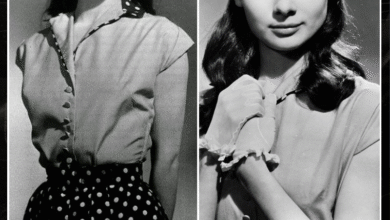The Tragic Story of Marilyn Monroe’s Early Years: Kidnapped by Her Own Mother and a Life of Instability
OPINION: This article may contain commentary which reflects the author's opinion.
Marilyn Monroe, born Norma Jeane Mortenson on June 1, 1926, in Los Angeles, California, is known today as one of Hollywood’s most iconic figures. However, her early life was marked by hardship, instability, and deep emotional struggles that would shape her character both personally and professionally. Monroe’s challenging start in life began with her placement in foster care at just two weeks old, following her mother, Gladys Pearl Baker’s, inability to provide proper care due to her mental health issues. This article delves into the early years of Monroe’s life, exploring her relationship with her mother, Gladys, and the complex circumstances that defined her childhood.
The Struggles of Gladys Pearl Baker
Gladys Pearl Baker, Monroe’s mother, was diagnosed with paranoid schizophrenia, a mental illness that severely affected her ability to care for her young daughter. At the time of Monroe’s birth, Gladys, then 26 years old, worked as a film cutter, but her mental health issues, including mood swings and erratic behavior, made it increasingly difficult for her to maintain a stable household. In January 1934, Gladys experienced a significant nervous breakdown, which led to her first institutionalization at Norwalk State Hospital.
Gladys’s condition deteriorated over time, affecting her relationship with her daughter and her ability to provide a stable home environment. Despite her struggles, Gladys did her best to stay connected with Monroe, often visiting her on weekends, taking her for outings, and spending short periods of time together. These visits, while irregular, provided the only semblance of connection between the two during Monroe’s early years.
The Foster Care Experience
At just two weeks old, Monroe was placed with the Bolender family in Hawthorne, California. The Bolenders offered Monroe a stable environment, providing her with a sense of structure and care that her mother was unable to provide. They taught her about conduct, morality, and religion, and Monroe lived with them until 1933. During this period, Gladys contributed $25 a month (approximately $444 in today’s money) to cover Monroe’s care, although her visits became less frequent as time passed.
Monroe’s time with the Bolenders was marked by a mix of affection and longing. Gladys, despite her own struggles, tried to maintain a presence in Monroe’s life, visiting on weekends and occasionally taking her on outings like beach trips and picnics. However, the frequency of these visits decreased, and by the time Monroe turned six, Gladys’s mental health challenges forced her to retreat further into psychiatric care, leaving Monroe to grow up in a series of foster homes and institutions.
Gladys’s Institutionalization and Their Complex Relationship
As Gladys’s condition worsened, she was institutionalized in various psychiatric facilities, including Norwalk State Hospital, Agnews State Mental Hospital, and Rockhaven Sanitarium, where she remained for much of her life. Her time in these institutions added complexity to her relationship with Monroe, who, despite the trauma of these experiences, continued to maintain some form of connection with her mother. In a particularly disturbing incident, Gladys once attempted to kidnap Monroe by stuffing her into a duffle bag, an act that was thwarted by her foster mother, Ida Bolender. Monroe later recounted how she would take sleeping pills after visiting Rockhaven Sanitarium, indicating the emotional toll these encounters had on her.
Despite the traumatic nature of these visits, Monroe continued to provide for her mother financially, sending her a monthly allowance even while she was living in various foster homes. This gesture reflected Monroe’s deep, though complicated, sense of loyalty and responsibility toward her mother, despite the emotional and psychological toll that Gladys’s condition had on her.
A Childhood Marked by Instability
Monroe’s childhood was characterized by an overwhelming sense of instability. After leaving the Bolenders in 1933, she moved between approximately 10 different foster homes and spent time in an orphanage between 1935 and 1942. During this time, Monroe faced significant hardships, including reports of sexual abuse by one of her foster family members. These painful experiences added to the emotional scars that Monroe would carry throughout her life.
Her formative years were deeply marked by a lack of permanence and security, a far cry from the glamorous image she would later project as Hollywood’s most famous star. Despite these early struggles, Monroe found ways to persevere and rise above her circumstances, using her beauty and talent to eventually secure a successful career in acting.
Long-Term Impact and Reflection
In later years, Monroe would speak candidly about the challenges she faced as a child and the complicated relationship she had with her mother. Though she was deeply affected by the emotional scars left by her early life, she also expressed a sense of empathy for her mother, acknowledging the pain and hardship that Gladys endured due to her mental illness.
Monroe’s experiences growing up in foster care and dealing with her mother’s instability had a profound impact on her sense of identity, self-worth, and relationships. The psychological toll of her early life remained with her, contributing to the personal struggles she faced in adulthood.
Conclusion: A Story of Survival and Compassion
Audrey Hepburn’s early life, marked by severe hardship and instability, shaped her into the resilient and compassionate woman she became. The bond she shared with her mother, Gladys, despite the difficulties they faced, reflects the complexities of love, loyalty, and the deep emotional impact of early life experiences. Monroe’s story is a testament to her resilience in overcoming the odds, while also demonstrating the long-lasting effects that a tumultuous childhood can have on an individual’s sense of identity and self-worth. Despite everything, Monroe’s journey remains a story of survival, love, and the complexities of family bonds that shaped her legacy as both a star and a symbol of strength.



